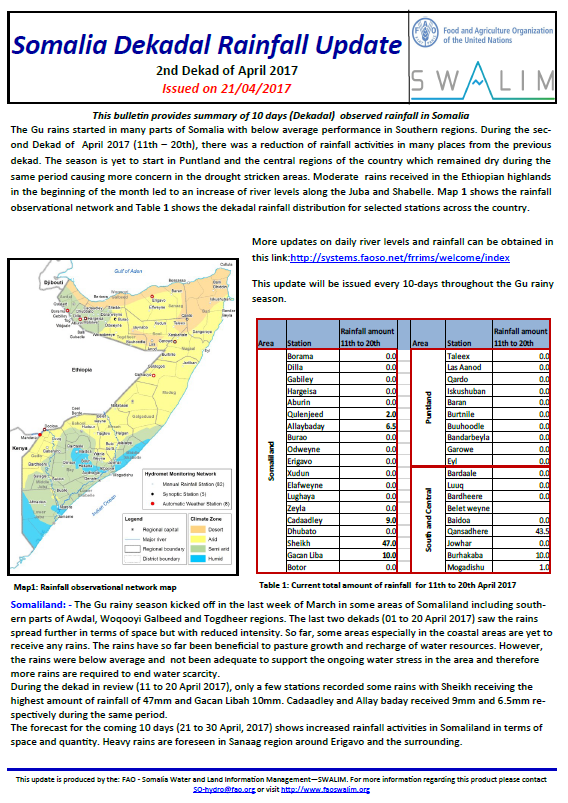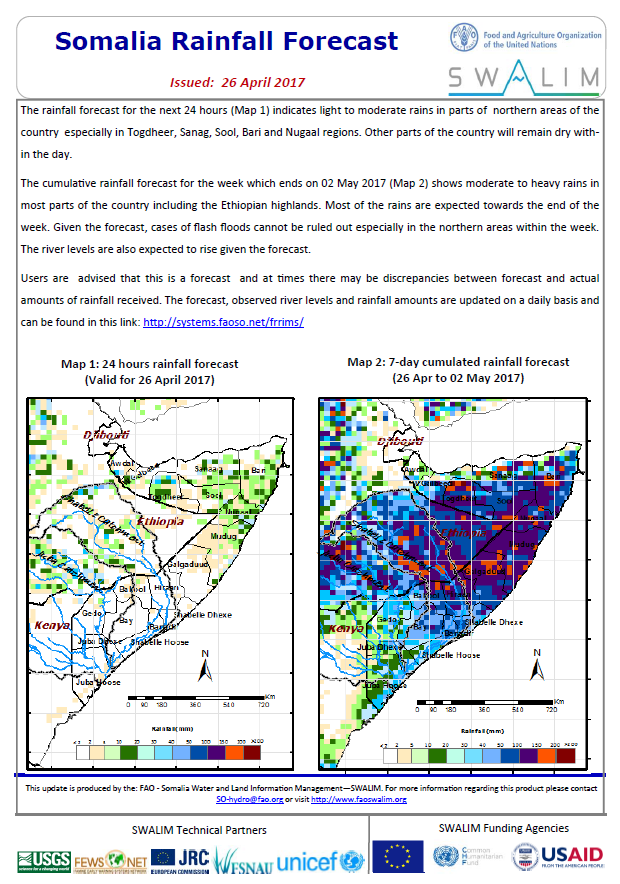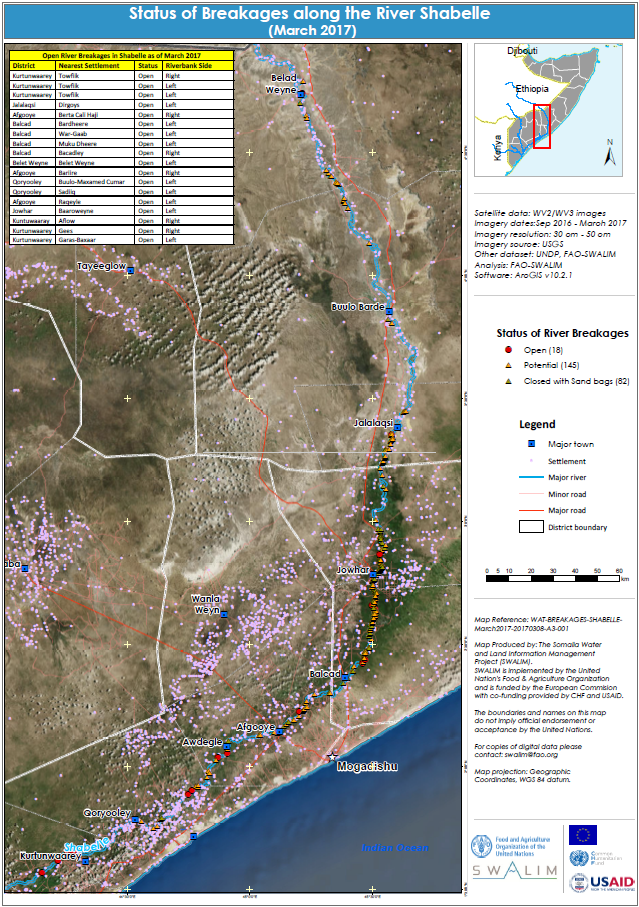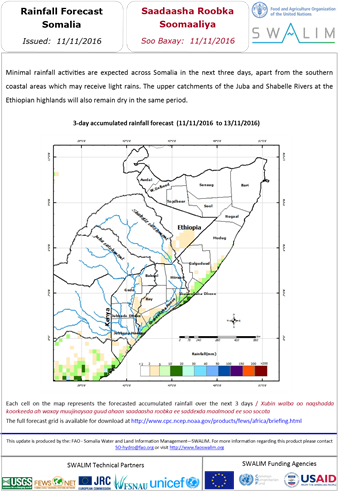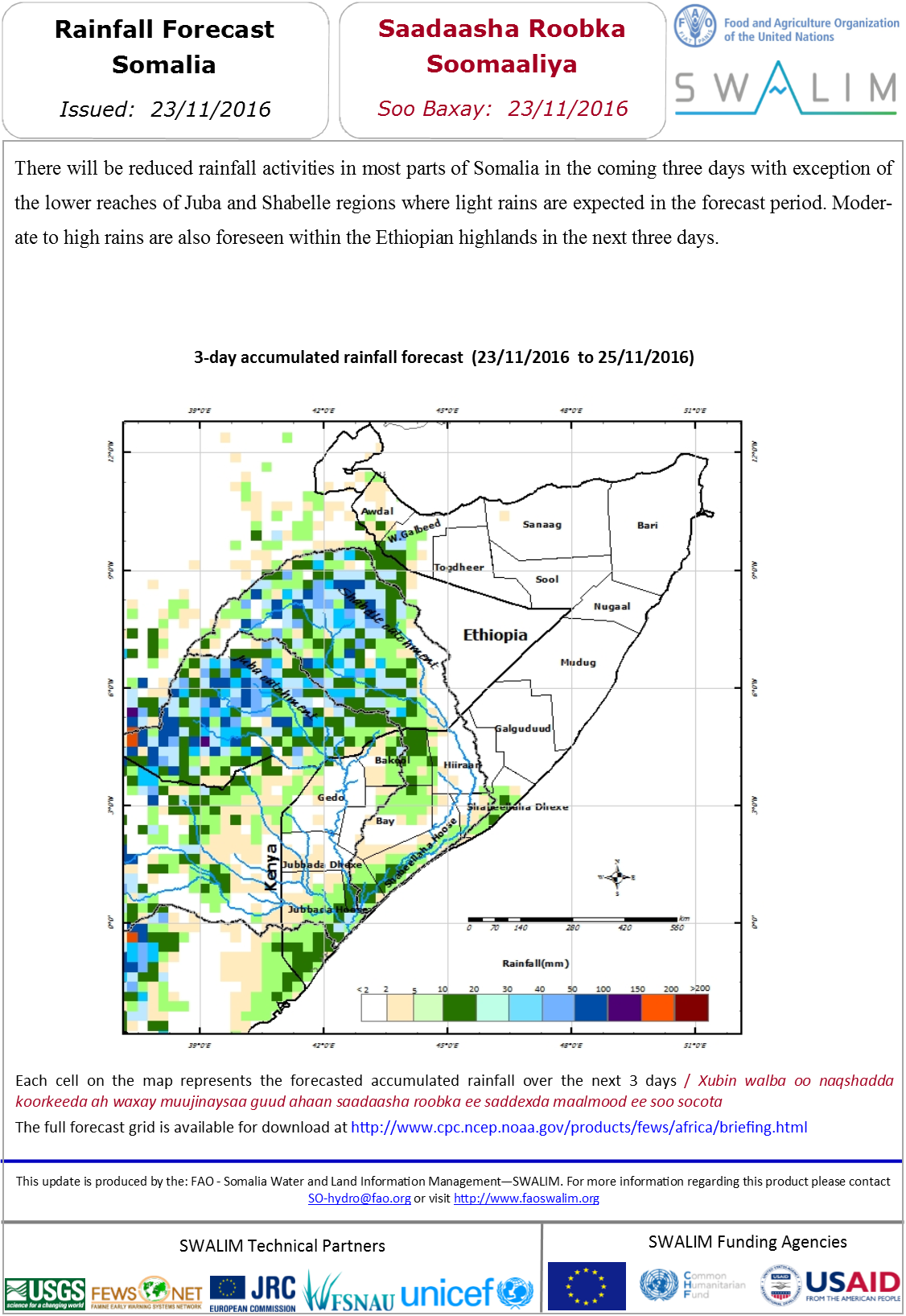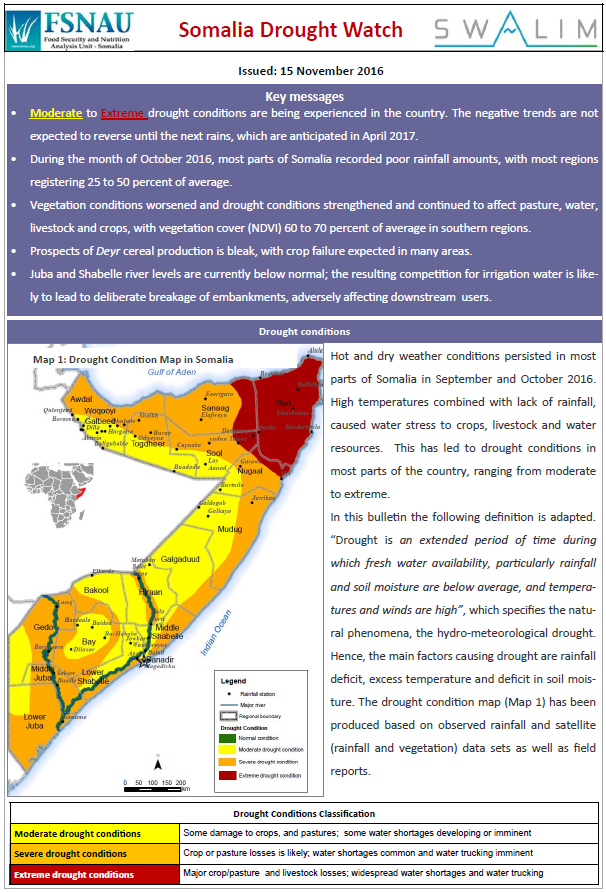Library Catalog
Latest Documents and Publications listed. Use search terms in the box below to find what you need
Somalia Rainfall Forecast 05-04-2017
The Gu 2017 rainy season started in parts of Somaliland during the last week of March with the southern parts of Awdal region recording heavy rains that were distributed within five days. This brought an immediate relief to water stress in the area. The other parts of the country are expected to start receiving the Gu rains by mid April.
The rainfall forecast for today (Map 1) indicates light rains of up to 20mm in the southern regions, parts Somaliland and the Ethiopian highlands. The rains re expected to increase in the same areas towards the end of the week as seen in Map 2 which is valid up to 11 April 2017. Little or no rains are foreseen in Puntland and central regions during the forecast period.
Publication Type:
Rainfall Forecast
Publication Date:
Author:
Corporate Author:
Somali Dekadal Rainfall - Dekad 11 of 2017
The Gu rains started in may parts of Somalia with below average performance in Southern regions. During the second Dekad of April 2017 (11th – 20th), there was a reduction of rainfall activities in in many places from the previous dekad. The season is yet to start in Puntland and the central regions of the country which remained dry remained dry during the same period causing more concern in the drought stricken areas. Moderate rains received in the in the Ethiopian highlands in the beginning of the month led to an increase of river levels along the Juba and Shabelle.
Publication Type:
Dekadal Rainfall Update
Publication Date:
Author:
Corporate Author:
Saadaasha Roob-daidda Soomaaliya 05-04-2017
Xilligii Guga sanadka 2017 wuxuu ka bilowday qaybo ka mid ah Soomaalilan intii lagu guda jirey toddobaadkii laga soo gudbay ee Maarso iyadoo qaybaha koonfureed ee Gobolka Awdal la diiwaaniyey roobab mahiigaan ah oo ku fidsanaa shan maalmood. Tani waxay keentay in degdeg looga soo kabsado cadaadiskii deegaanka biyaha ka haystay. Qaybaha kale ee dalka waxaa la filayaa in ay bilaabato helitaanka roobabkii Guga marka la gaaro bartamaha Abriil.
Saadaasha roob-da’idda maanta (Khariidad 1) waxay muujinaysaa roobab fudud oo gaaraya ilaa 20mm gudaha Gobollada Koonfureed, qaybo ka tirsan Soomaaliland iyo Buuraleyda sare ee Itoobiya. Roobabka waxaa la filayaa inay ku kordhaan isla deegaannadaan ilaa dhammaadka toddobaadka sida lagu arkayo gudaha Khariidadda 2 taas oo sax uun ku ah ilaa 11 Abriil 2017. Xoogaa ama roob la’aan ay la saadaalinayaa gudaha Puntland iyo Gobollada Dhexe inta lagu guda jiro muddada la odorosay.
Publication Type:
Rainfall Forecast
Publication Date:
Author:
Corporate Author:
Somalia Rainfall Forecast 26-04-2017
The rainfall forecast for the next 24 hours indicates light to moderate rains parts of northern areas of the country especially in Togdheer, Sanag, Sool, Bari and Nugaal regions. Other parts of the country will remain dry within the next 24 hours.
The cumulative rainfall forecast for the week which ends on 02 May 2017 shows moderate to heavy rains in most parts of the country including the Ethiopian highlands. Most of the rains are expected towards the end of the week. Given the forecast, cases of flash floods cannot be ruled out especially in the northern areas within the week. The river levels are also expected to rise given the forecast.
Users are advised that this is a forecast and at times there may be discrepancies between forecast and actual amounts of rainfall received.
Publication Type:
Rainfall Forecast
Publication Date:
Author:
Corporate Author:
Somalia Rainfall Forecast 06-04-2017
Light rains were reported in a few places in southern regions of Somalia in the last 24 hours. Belet Weyne in Hiraan recorded 5mm of rainfall while Wanle Weyne in Lower Shabelle, and Bur Hakaba in Bay received a total of 10mm and 8mm respectively. Light rains were also reported in a few pockets of the western side of Somaliland while no rains were reported in Puntland during the same period.
Field reports also indicate light to moderate rains within the Ethiopian highlands.
The rainfall forecast for today (Map 1) indicates light rains of up to 20mm in the southern regions, parts Somaliland and the Ethiopian highlands. The rains will increase in the same areas in terms of space and quantity as the week progresses as seen in Map 2 which is valid up to 12 April 2017. Little or no rains are foreseen in Puntland and central regions during the forecast period.
Given the forecast, the river levels along the Juba and Shabelle are expected to increase with no risk of flooding during the coming week. The levels and rainfall forecast are updated on a daily basis and can be found in this link:
http://systems.faoso.net/frrims/
Publication Type:
Rainfall Forecast
Publication Date:
Author:
Corporate Author:
Status of Juba and Shabelle River Breakages - March 2017
The Gu 2017 (March/April to June) rainfall forecast points towards near-normal to below-normal rains within the Juba and Shabelle River basins. However, flooding along the two rivers may still occur, especially in areas with open river banks/weak river embankments, in the event of increased river flow.
SWALIM has updated the status of the river breakages by mapping them using available Very High Resolution (VHR) satellite imagery and a Digital Elevation Model (DEM); as well as verifications based on field observations where feasible. All the observations reported refers to the latest suitable VHR satellite image available, which is indicated in the online database.
Four types of breakages have been identified, namely; open, potential, closed with sandbags and closed. The open breakages are those that are still open as observed on the latest VHR image available, therefore a field verification is needed before planning any repair. The potential breakages represent points that have weak river embankments. The closed with sandbags points are defined here as those that been temporarily closed with sandbags making them still vulnerable for further breakages. The closed points are those that were previously open but have since been closed using heavy machinery, which prevents further flooding in the short to medium term.
The attached maps show the open, potential and closed with sandbags points along the two rivers. In summary, eighteen (18) open points along the Shabelle and nineteen (19) along the Juba were identified. Several other points, which are either potential or temporarily closed with sandbags, have been identified.
It is worth noting that the methodology relies heavily on satellite images with limited field verification. Open breakages might have been omitted in some cases where satellite images may not have been very clear (e.g. heavy cloud cover) or were not available at all.
Maps of the status of river breakages, with detailed information, have been produced at large scale and can be obtained from SWALIM offices.
Publication Type:
Map
Publication Date:
Author:
Corporate Author:
Update on drought situation and river levels along Shabelle River
Most parts of Somalia are facing serious drought conditions with the larger part of the population facing severe to extreme drought conditions. Since the last half of 2016, the severity has been spreading spatially and the impacts getting worse with time. Some climate models are already predicting a poor rainy season in the coming season which may further aggravate the existing drought conditions. However, this forecast will be confirmed in the coming month during a regional Climate Outlook Forum.
The months of January and February usually experience the lowest amounts of river flow along the Shabelle River. January 2017, has however seen significantly below normal levels along the river since the beginning of the month. Some parts of the river in the lower reaches have dried up. This has been caused by below normal rains experienced in the upper parts of the Shabelle basin during the previous season which in turn has led to reduced river flow and over utilization of the river water for various uses both in Ethiopia and inside Somalia.
Publication Type:
Drought watch
Publication Date:
Author:
Corporate Author:
Somalia Rainfall Forecast 11-11-2016
Waxaa guud ahaan Soomaalia la filayaa roob yaraan saddexda maalmood ee soo socota, marka laga reebo meelaha xeebaha koonfureed kuwaas oo laga yaabo inay helaan roobab fudud. Qaybta biyo-qabatinka sare ee Webiyada Juba iyo Shabeelle ee xagga buuraleyda saree e Itoobiya waxay iyaduna sidoo kale ahaan doontaa qalayl isla muddada iyada ah.
Publication Type:
Rainfall Forecast
Publication Date:
Author:
Corporate Author:
Saadaasha Roobka Somalia 23-11-2016
Saddexda maalmood ee soo socota waxaa ka jiri doona inta badan qaybaha dhulka Soomaaliya roob yaraan marka laga reebo dhanka hoose ee gobollada Juba iyo Shabeelle halkaas oo laga filaayo roobab fudud muddada la saadaaliyey. Roobab dhexdhexaad ilaa kuwo badan ayaa sidoo kale laga saadaaliyey dhulka-sare ee Itoobiya saddexda maalmood ee soo aadan.
Publication Type:
Rainfall Forecast
Publication Date:
Author:
Corporate Author:
SWALIM-FSNAU Drought Watch Bulletin 15-11-2016
The Somalia Water and Land Information Management (SWALIM) and the Food Security and Nutrition Analysis Unit (FSNAU) are pleased to share with you their joint publication: Somalia Drought Watch for October 2016. The key highlights are:
1). Moderate to Extreme drought conditions are being experienced in the country. The negative trends are not expected to reverse until the next rains, which are anticipated in April 2017.
2). During the month of October 2016, most parts of Somalia recorded poor rainfall amounts, with most regions registering 25 to 50 percent of average.
3). Vegetation conditions worsened and drought conditions strengthened and continued to affect pasture, water, livestock and crops, with vegetation cover (NDVI) 60 to 70 percent of average in southern regions.
4). Prospects of Deyr cereal production are bleak, with crop failure expected in many areas.
5). Juba and Shabelle river levels are currently below normal; the resulting competition for irrigation water is likely to lead to deliberate breakage of embankments, adversely affecting downstream users
Publication Type:
Drought watch
Publication Date:
Author:
Corporate Author:
Pages
 RSS feed [compliant with the Agris AP] |
RSS feed [compliant with the Agris AP] |  Agris AP XML
Agris AP XML



